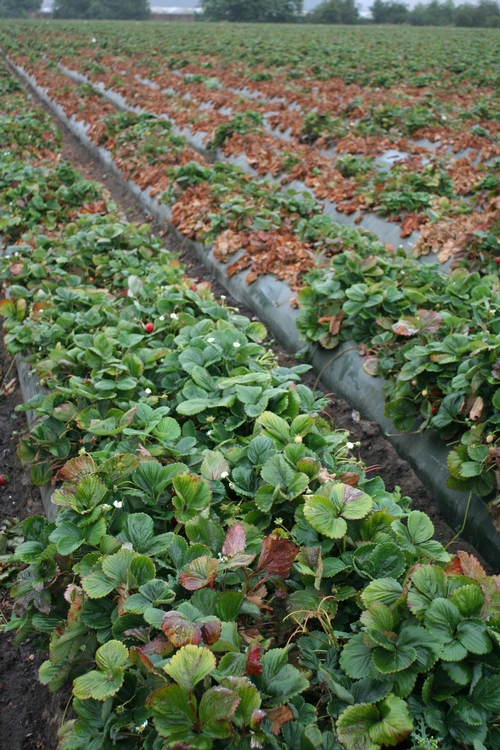As I think many of you have been doing, I've been cracking the pages of the latest CalAg edition dedicated to berries.
The following article, written by Tom Gordon of UC Davis and his former graduate student Margaret Lloyd – now serving as a Farm Advisor in Yolo, Solano and Sacramento Counties – concerns an aspect of berry culture as we move into an environment of less effective soil fumigation.
http://ucanr.edu/repositoryfiles/ca2016a0009-161770.pdf
Highlights:
1- The increase of soil pathogens we are experiencing in strawberries has been concomitant with decreased soil fumigant availability not just here, but also in Spain, Israel and South Korea. In other words, buckle up because the best is yet to come.
2- A higher level of genetic resistance to soil disease in strawberry will not be the cure all, but rather it must be used together with a means of reducing soil pathogen inoculum load in the soil. This combination was understood for a long time by the UC strawberry breeding program, and should not be forgotten.
3- The only route to pathogen inoculum reduction in soil is not necessarily soil fumigation. Rotation with non-host crops is one (indeed, the authors state that in general inoculum loads can be decreased by 50% per year in the absence of host plants) is given as one.
4- Not introducing pathogens into the field in the first place is important and one should be paying attention to movement of soil, on people, tools and machinery in and out of fields. An important note, and I'll write it in bold so you don't miss it, is that a pathogen population must increase to a certain threshold before it causes disease, in other words the absence of visible signs of disease does not mean a field is clean.
5. The final page is the most interesting, in that it discusses the idea of a regional plan for maintaining uninfested, pathogen free soil as a fundament of a thriving agricultural industry in the reduction or even absence of effective soil fumigation.
To begin, the system of rotating berries and vegetables as we have done for decades on the Central Coast may no longer tenable in the absence of an effective fumigant. For those not familiar with the system of cropping in the Pajaro and Salinas Valleys, a very generalized picture has been the fumigation of soil, followed by a crop of strawberries, and then rotated to lettuce or cool season vegetables which oh yes very much benefited from the fumigation for the berries a year or more prior. Following the vegetable crop, fume again to set the pathogen population back to zero, plant berries followed again by vegetables. And repeat.
What to do now as the effectiveness of our fumigation slips is the question very much on the front of the minds of farmers, researchers and businesspeople.
We all understand that private land is private land, and to suggest regulation over it from an outside agency is anathema in the United States, as it should be. Then again, that much of the privately owned farming land in the Pajaro and Salinas Valleys is leased and used by multiple growers, who produce food for millions and employ thousands, means that the preservation of the quality of land and the usability and productivity of its soil, is of more than individual interest and enters into the realm of a public good.
The article briefly explores how the maintenance of productive, pathogen free soils could be incentivized. The development and deployment of tools to identify sick soils that could bring risk to a grower's bottom line is one route. Much in the same way Carfax informs the used car buyer what is up with his or her intended purchase, a contaminated soil will be known by both lessor and potential lessee to be so, and as such would be negotiated at a lower rate than a soil which is clean and presents less risk of loss.
The other more intriguing, and far more difficult in my mind, is the development of local cooperative governing mechanism for soil management. This is a huge topic, but would be something that growers and landowners create and agree to amongst themselves. Something along the lines of the agreement in the 1960's of Salinas lettuce growers to adopt a “lettuce free” period to manage lettuce mosaic disease is given as an example. As far as I know, this wasn't imposed on people by the State or some sort of enforcement agency threatening fines or punishment, rather growers agreed to it since it clearly benefits everyone and as such still stands today.
Lots to think about here, good article by Tom Gordon and Margaret Lloyd.
Attached Images:
